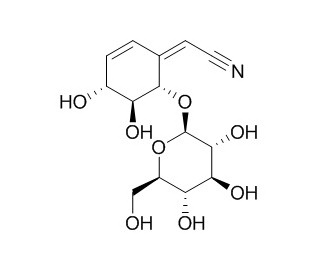Lithospermoside
Lithospermoside has anti-oxidant,and anti-tumor promoting activities.
Inquire / Order:
manager@chemfaces.com
Technical Inquiries:
service@chemfaces.com
Tel:
+86-27-84237783
Fax:
+86-27-84254680
Address:
1 Building, No. 83, CheCheng Rd., Wuhan Economic and Technological Development Zone, Wuhan, Hubei 430056, PRC
Providing storage is as stated on the product vial and the vial is kept tightly sealed, the product can be stored for up to
24 months(2-8C).
Wherever possible, you should prepare and use solutions on the same day. However, if you need to make up stock solutions in advance, we recommend that you store the solution as aliquots in tightly sealed vials at -20C. Generally, these will be useable for up to two weeks. Before use, and prior to opening the vial we recommend that you allow your product to equilibrate to room temperature for at least 1 hour.
Need more advice on solubility, usage and handling? Please email to: service@chemfaces.com
The packaging of the product may have turned upside down during transportation, resulting in the natural compounds adhering to the neck or cap of the vial. take the vial out of its packaging and gently shake to let the compounds fall to the bottom of the vial. for liquid products, centrifuge at 200-500 RPM to gather the liquid at the bottom of the vial. try to avoid loss or contamination during handling.
Bioorg Med Chem.2020, 28(12):115553.
Front Plant Sci.2020, 10:1705
LWT2021, 138:110397.
J Agric Food Chem.2024, acs.jafc.4c01387.
Plants (Basel).2021, 10(2):278.
Auburn University2015, 1-58
Appl. Sci. 2024, 14(13), 5815
Biomolecules.2023, 13(2):227.
Herbal Formula Science2024, 32(2):155-179.
Molecules.2017, 22(11)
Related and Featured Products
Nat Prod Res. 2015 Jan 2:1-4.
Cytotoxic flavonoids and other constituents from the stem bark of Ochna schweinfurthiana.[Pubmed:
25553908]
Seven flavonoids, hemerocallone (1), 6,7-dimethoxy-3',4'-dimethoxyisoflavone (2), amentoflavone (4), agathisflavone (6), cupressuflavone (8), robustaflavone (9) and epicatechin (10), together with three other compounds, Lithospermoside (3), β-D-fructofuranosyl-α-D-glucopyranoside (5) and 3β-O-D-glucopyranosyl-β-stigmasterol (7), were isolated from the ethyl acetate extract of the stem bark of Ochna schweinfurthiana F. Hoffm.
METHODS AND RESULTS:
All the compounds were characterised by spectroscopic and mass spectrometric methods, and by comparison with literature data. Cytotoxicity of the extracts and compounds against cervical adenocarcinoma (HeLa) cells was evaluated by MTT assay.
CONCLUSIONS:
Compounds 4 and 6 exhibited good cytotoxic activity, with IC50 values of 20.7 and 10.0 μM, respectively.
Cancer Lett. 1999 Aug 23;143(1):5-13.
Anti-tumor promoting activity of polyphenols from Cowania mexicana and Coleogyne ramosissima.[Pubmed:
10465331]
METHODS AND RESULTS:
Chemical investigation on polyphenol-rich fractions of Cowania mexicana and Coleogyne ramosissima (Rosaceae) which showed significant inhibitory effects on Epstein-Barr virus early antigen (EBV-EA) activation induced by 12-O-tetradecanoylphorbol-13-acetate (TPA), has led to the characterization of 10 compounds including C-glucosidic ellagitannin monomers and dimers from the former plant, and 17 polyphenols including flavonoid glycosides from the latter. The effects of individual components and their analogues with related structures on the TPA-induced EBV-EA activation were then evaluated. Among the compounds isolated from C. mexicana, two C-glucosidic ellagitannins, alienanin B and stenophyllanin A and a nitrile glucoside (Lithospermoside), and among the constituents from C. ramosissima, two flavonoid glycosides, isorhamnetin 3-0-beta-D-glucoside and narcissin were revealed to possess strong inhibitory effects on EVB-EA activation, the potencies of which were either comparable to or stronger than that of a green tea polyphenol, (-)-epigallocatechin gallate.
CONCLUSIONS:
These polyphenols except for nitrile glucoside, which was not tested owing to an insufficient amount, were also found to exhibit anti-tumor promoting activity in two-stage mouse skin carcinogenesis using 7,12-dimethylbenz[a]anthracene (DMBA) and TPA.
J Nat Prod. 2006 Aug;69(8):1206-8.
Minor biflavonoids from Lophira alata leaves.[Pubmed:
16933877]
The leaves of the Cameroonian medicinal plant Lophira alata afforded two new biflavonoids, lophirone L (1) and lophirone M (2), and the known luteolin and Lithospermoside. Both biflavonoids were obtained in small quantities, and their structures show some new and unusual biflavonoid diversity.



